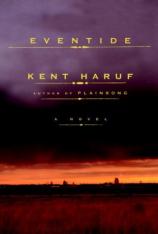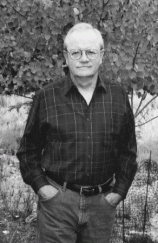Reading Group Guide
Discussion Questions
Eventide

1. Two elderly bachelors living on an isolated ranch in eastern Colorado–not what one would immediately consider an exciting premise for a work of fiction. How does Kent Haruf transform the mundane materials of his characters and setting into such an emotionally compelling story?
2. In what ways does Eventide deepen readers' relationships with those characters who also inhabit Haruf's previous novel Plainsong? How are the two novels alike? In what ways are they significantly different?
3. What kind of men are Harold and Raymond McPheron? What are their most distinctive and appealing characteristics? What makes them so likable?
4. Why does Haruf interweave, in alternating chapters, the stories of the McPheron brothers and Victoria Roubideaux, Luther and Betty Wallace and Rose Tyler, Hoyt Raines, DJ Kephart and his grandfather, and Mary Wells and her daughters? How are their lives interconnected? In what ways do they represent a wide spectrum of American society?
5. When Tom Guthrie and his sons finish separating the cows and their calves, Ike Guthrie says, "They make an awful lot of noise. . . . They don't seem to like it much." To which Tom replies, "They never do like it. . . . I can't imagine anything or anybody that would like it. But every living thing in this world gets weaned eventually" [p. 155]. How does this statement illuminate the central themes of Eventide? In what ways is the novel about the pain of separation, of getting "weaned"?
6. Haruf's writing, like the speech of the characters he writes about, is restrained, as when Raymond calls Victoria to tell her of Harold's death:
Honey, I got something to tell you.
Oh, no, she said. Oh no. No.
I'm just afraid I do, he said. And then he told her [p. 80].
Why does Haruf end the conversation there? Why is it more moving to let the reader imagine the rest of the conversation than to describe it more completely? Where else in the novel does Haruf show this kind of reserve?
7. When Del Gutierrez tells Raymond that he can't see how just one man can run the ranch–"It seems like too much for one person to do"–Raymond responds, "What else you going to do?" [p. 233]. How does this response typify Raymond's attitude about life and his own predicament?
8. When Raymond worries that they might have to wait until seven-thirty to have dinner, Rose says, "You wouldn't do very well in New York or Paris, would you," and Raymond replies: "I wouldn't even do very good in Fort Morgan" [p. 255]. Why wouldn't Raymond do well in a big city? In what ways is he suited to, and a product of, the rural life of the high plains?
9. Why has Haruf included a character like Hoyt Raines in the novel? What does he add to the emotional texture of the book?
10. Parent-child relationships are important in Eventide. What kinds of behavior does the novel dramatize between parents (or grandparents or surrogate parents) and children? How are children seen and treated by their elders in the book? What are the best and worst examples of parent-child relationships in Eventide?
11. Near the end of the novel, Luther and Betty Wallace's children are placed in a foster home. Why does the court make this decision? Is it the right one? Does Haruf intend for readers to regard Luther and Betty critically, sympathetically, or with some mixture of feelings?
12. Why is the budding romance between Rose and Raymond so appealing? Why must Raymond be tricked into meeting her? Why are they so drawn to each other?
13. Eventide ends with Raymond and Rose sitting together quietly, "the old man with his arm around this kind woman, waiting for what would come" [p. 300]. Why is this a satisfying way to end the novel? What is likely to come for them? Literary works often imply, if only implicitly, a set of values to live by. What attitudes and values does Eventide seem to hold up for emulation?
Eventide
- Publication Date: May 4, 2004
- Genres: Fiction
- Hardcover: 320 pages
- Publisher: Knopf
- ISBN-10: 0375411585
- ISBN-13: 9780375411588








